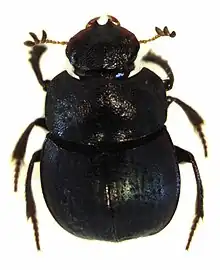| Saphobius | |
|---|---|
 | |
| Saphobius edwardsi | |
| Scientific classification | |
| Kingdom: | |
| Phylum: | |
| Class: | |
| Order: | |
| Suborder: | |
| Superfamily: | |
| Family: | |
| Subfamily: | |
| Tribe: | |
| Genus: | Saphobius |
Saphobius is a genus of dung beetles in the tribe Deltochilini of the subfamily Scarabaeinae. They are endemic to New Zealand, with Saphobius edwardsi being most widespread.[1] They are small in size, flightless, forest dwelling and nocturnal,[1] which is unusual for dung beetles.[1]
Dung beetles are typically associated with mammal faeces,[2] but prior to human habitation, New Zealand lacked land mammals other than three species of bats.[1] This lack of mammal faeces has been suggested as the reason for the low diversity of dung beetles in New Zealand when compared to the rest of the world.[1][3] Olfaction studies and pitfall trap baiting trials have shown that chicken carcasses and squid are highly attractive to Saphobius, which may reflect the evolution of the genus on an island abundant with bird species, in particular sea birds.[4][5]
Taxonomy
The New Zealand Organisms Register lists these species.[6]
- Saphobius brouni (Paulian, 1935)
- Saphobius curvipes (Broun, 1893)
- Saphobius edwardsi (Sharp, 1873)
- Saphobius fulvipes (Broun, 1893)
- Saphobius fuscus (Broun, 1893)
- Saphobius inflatipes (Broun, 1893)
- Saphobius laticollis (Broun, 1914)
- Saphobius lepidus (Broun, 1912)
- Saphobius lesnei (Paulian, 1935)
- Saphobius nitidulus (Broun, 1880)
- Saphobius setosus (Sharp, 1886)
- Saphobius squamulosus (Broun, 1886)
- Saphobius tibialis (Broun, 1895)
- Saphobius wakefieldi (Sharp, 1877)
References
- 1 2 3 4 5 Jones, Asher G.; Forgie, Shaun A.; Scott, David J.; Beggs, Jacqueline R. (2012-04-01). "Generalist dung attraction response in a New Zealand dung beetle that evolved with an absence of mammalian herbivores". Ecological Entomology. 37 (2): 124–133. doi:10.1111/j.1365-2311.2012.01344.x. ISSN 1365-2311. S2CID 85356532.
- ↑ Hanski, Ilkka (2014). Hanski, Ilkka; Cambefort, Yves (eds.). Dung Beetle Ecology. Princeton University Press. doi:10.1515/9781400862092. ISBN 9781400862092.
- ↑ Davis, Adrian L. V.; Scholtz, Clarke H. (2001-07-01). "Historical vs. ecological factors influencing global patterns of scarabaeine dung beetle diversity". Diversity and Distributions. 7 (4): 161–174. doi:10.1111/j.1472-4642.2001.00102.x. ISSN 1472-4642.
- ↑ Stavert, Jamie R.; Drayton, Bradley A.; Beggs, Jacqueline R.; Gaskett, Anne C. (2014-10-01). "The volatile organic compounds of introduced and native dung and carrion and their role in dung beetle foraging behaviour". Ecological Entomology. 39 (5): 556–565. doi:10.1111/een.12133. ISSN 1365-2311. S2CID 82796507.
- ↑ Seldon, David S.; Beggs, Jacqueline R. (2010-02-01). "The efficacy of baited and live capture pitfall traps in collecting large-bodied forest carabids". New Zealand Entomologist. 33 (1): 30–37. CiteSeerX 10.1.1.619.9659. doi:10.1080/00779962.2010.9722189. ISSN 0077-9962. S2CID 87910405.
- ↑ "Saphobius". New Zealand Organisms Register. Landcare Research. Retrieved 2017-09-06.